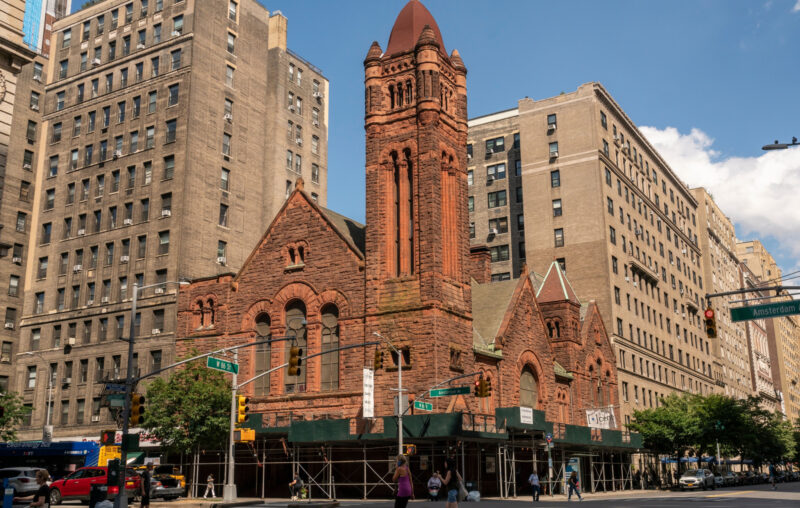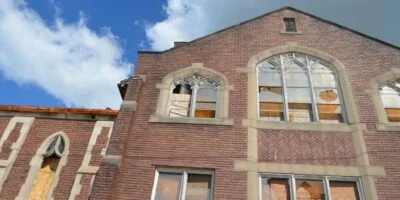Ownership of Churches: Congregation, Neighbors, or the City?

Once a vibrant church with a storied past, West Park Presbyterian Church has found itself in a battle over property rights. Established in the Upper West Side of New York City in 1852, it supported the LGBT movement as it gained popularity in 1978, and delivered meals during the AIDS epidemic.
Now church attendance has dwindled to 12 members, and the church leaders and congregation want to sell the building and grounds. Neighbors, including some celebrities, oppose it on the grounds that the church gives value to the neighborhood and have voiced their opposition to the sale.
Since the church owns the entire property, its congregation and leadership think they should have a final say in what happens to the building. The NYC Landmark Preservation Commission, however, designated the church as a historical landmark in 2010, thereby blocking the wishes of the church leadership.
With such a small congregation they cannot afford to maintain and restore the property. As owners of the property, they want to reclaim their rights over it so they can legally trade or transfer the building.
A landmark designation “preserves and protects these properties from being demolished or significantly altered in a way that would detract from their historical or cultural value.” Built in the late 19th Century, the building has been described as “one of the best examples of a Romanesque Revival-style religious structure in New York City.”
When the Landmark Commission deliberated conferring landmark status to the church building in 2010, they believed the community would fund the needed renovations. But due to high estimates for renovation costs—the church leaders filed a petition to remove the landmark designation on hardship grounds in June 2022.
The church leadership was given an estimate for repair costs that exceed $50 million, including $17 million to repair the exterior. Over the past 7 years, the church has spent more than $1 million in repairs, funded by the sale of some assets, including a manse.
They have tried to find other solutions, including a below-market rental to a non-profit arts facility, the Center at West Park, in return for a promise to restore the building. Despite numerous art-oriented events, the Center failed to earn sufficient funds to fulfill their promise.
Revocation of the landmark designation would allow the church leadership to sell the property to Alchemy Properties for $30 million. They would demolish the church, erect a 19-story condominium on the land, and provide space for the church and other non-profits within the new building.
Neighbors, however, objected to this plan and took steps to ensure that the church’s ownership rights would continue to be restrained by its landmark status. Some of the more noted celebrities lobbied the Mayor’s office, insisting that it is in the interest of New York City for such an important piece of its history to be preserved.
They may care about the past, but they are likely hoping to enjoy “positive externalities” for free while church members bear current maintenance and future renovation costs. Immediate neighbors also enjoy a less crowded neighborhood without the occupants of a 19-story building.
Indeed, their concern for the heritage of the City wears thin, as the deteriorating façade has warranted scaffolding over the sidewalk for more than 20 years. Passersby cannot truly appreciate the history of the building; they must live next to or near the building to gain advantages from it.
The lovely church and an expectation of the status quo may have increased real estate prices in the neighborhood. Thus, the change in status of the property might cause some current owners to incur losses.
In this case, Ronald Coase suggests that neither party can be identified as a “victim,” even if using a resource injures any other party(s). Compelling the original actor to cease and desist to avoid injuring or imposing costs on someone else will cause injury or losses to the former.
Restoring property rights to the church would allow bargaining with other affected parties and would provide the church a way to determine its destiny. When externalities exist and interested parties can negotiate and trade, they can discover who puts the highest value on using or possessing a resource.
This opens the way for some solutions to the disparate interests of the owners of the church and its neighbors. If the landmark designation is lifted, the neighbors could reveal their values by bidding against the developer or offering to pay the church for the renovation and upkeep.
Or the City could eliminate property tax exemptions for this and all other religious properties. Alternatively, the City could acquire the church grounds and allow it to be converted into an interfaith space or be available for secular community activities.
It could be argued that refusal by City officials to retract the landmark designation might constitute a “taking.” If so, the courts might decide that the church should receive compensation.
Compared to solutions offered by government officials, market-based solutions of negotiation, cooperation, and exchange reflect the diverging interests of all those affected. This claim is based on Public Choice economics, which applies economic analysis in the context of political governance.
Incentives influence the choices that self-interested individuals make, and people want to improve their lot, at least ex ante. Public-sector officials have their own goals and will act in the same self-interested manner as other individuals.
Leaving the fate of the Church to the Landmark Preservation Commission or the mayor’s office would likely reflect the interests and values of individual public-sector actors. They will combine their ideological or partisan attachments with their self-interest in acquiring status, income, or approval.
As Hayek pointed out, public-sector officials cannot acquire the necessary knowledge to identify an “optimal” solution. This knowledge only emerges as part of the market process, when interested actors negotiate and cooperate to decide on the appropriate conditions for the transfer of property rights.
And that leaves us where the discussion began. New York City should restore property rights to the leaders and congregation of West Park Presbyterian Church.












